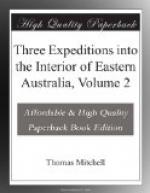Slow growth of trees.
A tribe of natives come to us.
Mr. Oxley’s bottle.
Waljeers Lake.
Trigonella suavissima.
Barney in disgrace.
A family of natives from the Murrumbidgee.
Inconvenient formality of natives meeting.
Rich tints on the surface.
Improved appearance of the river.
Inhabited tomb.
Dead trees among the reeds.
Visit some rising ground.
View northward.
Difficulties in finding either of the rivers or any water.
Search for the Murrumbidgee.
A night without water.
Heavy fall of rain.
Two men missing.
Reach the Murrumbidgee.
Natives on the opposite bank.
They swim across.
Afraid of the sheep.
Their reports about the junction of the Darling.
Search up the river for junction of Lachlan.
Course of the Murrumbidgee.
Tribe from Cudjallagong visits the camp in my absence.
Caught following my steps.
Piper questions them.
NORTH ARM OF THE LACHLAN.
April 17.
We proceeded along the right bank of the Lachlan, crossing at five miles a small arm or ana-branch* which had been seen higher up diverging from the river, and flowing towards the north-west by Mr. Oxley. The local name of it is Yamorrima. Beyond this watercourse Cannil plains extend and were more grassy than plains in general. I observed a small ridge of trap-rock near the river. We crossed soon after the base of Mount Torrens, also a hill of trap; and a continuation on this bank of the Lachlan of the Goulburn range. Mount Torrens is however only an elongated hill. The trap-rock reappears in some lower hills further northward, of which Mount Davison is the highest and most eastern.
(Footnote. See Footnote below.)
QUAWYS.
Beyond Mount Torrens we entered the region which lies to the westward of the Macquarie range, and found several new plants, especially a very pretty Xerotes, with sweetly perfumed flowers, being a good deal like X. leucocephala, but with the leaves filamentous at the edges, and the male spikes interrupted.* We encamped on a deep pond at a bend of the Lachlan named Gonniguldury. I learnt from the old native guide who accompanied us from Regent’s lake that they call those ponds of a river which never dry up quawy, a word which proved to be of use to us in descending the Lachlan. At this camp I found, by a careful observation of alpha and beta Centauri, that the magnetic variation was 8 degrees 56 minutes 15 seconds East.
(Footnote. X. typhina, Lindley manuscripts; acaulis, foliis longissimis angusto-linearibus margine laevibus filamentosis basi laceris, capitulis omnibus cylindraceis lanatis foemincis simplicibus masculis interruptis.)
WALLANGOME.
April 18.




